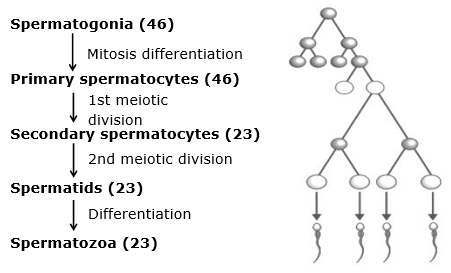Schematically represent and explain the events of spermatogenesis in humans.
OR
Angiosperm flowers may be monoecious, cleistogamous or show self-incompatibility. Describe the characteristic features of each one of them and state which one of these flowers promotes inbreeding and outbreeding respectively.
At Puberty

Figure. Schematically representation of spermatogenesis
• At puberty, in testis spermatogonia (the immature male germ cells) produce sperms by the process of spermatogenesis.
• On the inside wall of seminiferous tubules, the spermatogonia present.
• They are multiply by mitotic division and increase in numbers and each spermatogonium is diploid and contains 46 chromosomes.
• Primary spermatocytes periodically undergo meiosis and complete the first meiotic division (reduction division).
• The first mitotic division leading to the formation of two equal haploid cells called secondary spermatocytes having only 23 chromosomes each.
• For the production of four equal haploid spermatids, the secondary spermatocytes undergo for the second mitotic division.
• Spermiogenesis is the process by which the spermatids are transformed into spermatozoa (sperms).
OR
1) Monoeciousflower characteristics as follows:
• The flowers are unisexual.
• Like maize and castor, both male and female flowers are present on the same plant.
• It allows geitonogamy but prevents autogamy.
2) Cleistogamous flowers characteristics as follows:
• Cleistogamous flowers do not open at all.
• The anthers and stigma present close to each other.
• When anthers dehisce in the flower buds, to effect pollination pollen grains comein contact with the stigma.
• It is autogamous as there is no chance of cross-pollen landing on the stigma.
3)self-incompatibility
• It is a genetic mechanism by which self- pollination does not take place.
4)Monoecious and cleistogamous flowers promote inbreeding.
Outbreeding is promoted by flower showing self-incompatibility.